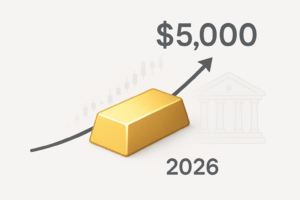Those who think they’ve “missed out” on gold are missing the point.
As Mike Maloney puts it: “If a ship goes down, those who paid more for their lifeboats aren’t any less happy than those who paid less.”
In his latest video, Mike describes what he calls the “lifeboat moment” for gold — a phase when physical demand surges, small bars vanish from the market, and ordinary investors rush to secure real metal before prices accelerate.
This isn’t a headline-driven pop. It’s a turning point.
The Small Gold Bar Shortage Has Begun
In Tokyo, Japan’s largest bullion dealer, Tanaka Kikinzoku, just suspended sales of its 5-, 10-, and 20-gram gold bars. Lines stretched five hours long outside its Ginza store.
Mike draws a historical parallel: this same pattern unfolded in 1980, when gold soared to record highs and buyers wrapped around city blocks, waiting for their chance to get in.
Once again, it’s happening — and not just in Japan. Retail investors worldwide are finding small bars harder to source, even as larger denominations remain available.
Central Banks Are Quietly Cornering the Market
While retail demand tightens, central banks are moving even faster. According to Mike, world central banks bought another 15 tons of gold in August, marking 27 months of net buying in the last 28.
That’s not normal market behavior — that’s accumulation on an institutional scale.
Tether, the world’s largest stablecoin issuer, added 19 tons to its balance sheet in just the first half of 2025 — roughly equivalent to what China’s central bank purchased during the same period.
Gold is being removed from circulation, month after month, by entities that rarely sell.
Gold Futures Cross $4,000 — and It’s Just the Beginning
For the first time in history, gold futures broke above $4,000 per ounce.
Spot gold hasn’t yet caught up, but Mike believes it’s a clear sign of what’s coming.
When paper markets lead physical ones, it often signals that demand is outpacing supply — and physical buyers are just a step behind.
At the same time, BullionStar reported one of its busiest days of 2025, with customers buying aggressively even as prices climb.
In Mike’s words, “Price isn’t deterring demand. Customers are securing physical assets rather than waiting for pullbacks that aren’t materializing.”
The Return of ‘Cash for Gold’ — But This Time It’s Different
Remember the “Cash for Gold” era of 2011? As gold spiked back then, shops popped up everywhere offering to buy your jewelry or coins.
Mike says that phase is returning — but this time, there will be far more buyers than sellers.
With both the S&P 500 and gold sitting at all-time highs, the question isn’t which one will fall — it’s which one’s real.
Gold, unlike equities or fiat currencies, doesn’t rely on someone else’s promise. It simply is.
And as the global financial system grows more fragile, investors are remembering why physical metal has always been the ultimate hedge.
The Lifeboat Moment Is Here
Mike’s message is clear: if you’re still waiting for the “perfect entry,” you may already be late. Gold’s move through $4,000 isn’t a spike — it’s a signal.
The combination of tight physical supply, record central bank buying, and skyrocketing futures prices points to a structural shift that’s just getting started.
As Mike reminds us, “Those who think they missed out are missing the point.”
People Also Ask
Why are small gold bars selling out in Japan?
Japan’s largest bullion dealer, Tanaka Kikinzoku, has sold out of 5-, 10-, and 20-gram bars as investors line up for hours to buy. Mike Maloney says this echoes 1980’s gold rush — when panic buying signaled the start of a major price surge. Listen to Mike talk about The Lifeboat Moment for Gold to learn more.
Are central banks still buying gold in 2025?
Yes. Central banks have been net buyers in 27 of the last 28 months, adding tons of gold to reserves. Mike notes this consistent accumulation is removing supply from the open market and helping push prices higher.
What does Mike Maloney mean by a “lifeboat moment” for gold?
Mike uses the “lifeboat” analogy to describe investors seeking safety as economic risk rises — similar to buying lifeboat seats on a sinking ship. He says gold’s “lifeboat moment” is here because real assets are being rushed faster than they’re replenished.
Should investors wait for a dip before buying gold?
Mike warns that waiting for a dip may be the costliest mistake of 2025. With physical shortages, strong central bank demand, and record futures prices, corrections are likely to be brief and shallow.
Will gold prices keep rising after hitting $4,000?
Mike Maloney believes $4,000 is only the beginning. With record central bank accumulation and tightening physical supply, the trend points toward even higher prices in the years ahead.
Get Gold & Silver Insights Direct to Your Inbox
Join thousands of smart investors who receive expert analysis, market updates, and exclusive deals every week.









